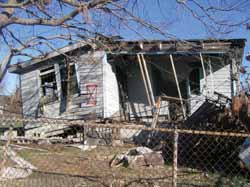Re-Imagining New Orleans
The elephant in the room. It's the image for a bad situation that's being ignored. But for a small group of students and alumni from Teachers College and
"When I saw that and when I saw the devastation in that neighborhood"- miles of empty homes with high watermarks still visible near their rooftops; mounds of dirt and wood; rusted cars; rotting clothing and furniture - "I became physically ill," remembers Deanna Belcher, a TC alumna who works as Service Learning Coordinator at The School at Columbia.
"The surroundings were unimaginable," says Emily Morgan, a first-year student at TC.
Yet when it comes to
"When September 11th happened, as horrific as that was, the nation came together - New York City rebounded and life returned, fairly quickly, to some semblance of normalcy," says Kelvin Sealey, whose course, "Experiments in Content: Education and Architecture," brought Belcher, Morgan and their classmates to the devastated city in February. "But Katrina's aftermath just continues. Most of the city remains in ruins. For the poor people there, who were already living in some of the worst conditions in the country, it just gets worse. And meanwhile, there is the very real danger that most people, after all the initial headlines, will turn their attention elsewhere. That visceral, human connection that people feel at the beginning begins to fade."
In September, Teachers College took in four graduate education students (free of charge) and a researcher who had been displaced by the storm. The researcher, Annie Weiss, who was studying emotional self-regulation in young children, has since formally joined TC's
"Some of our kids here are the poorest Americans in the country, and they're bringing in food for the evacuees," he says, adding that his
Yet it is Sealey's course - sponsored by Arts Education Professor Judith Burton and offered through the College's Center for Educational Outreach and Innovation (CEO&I) - that represents TC's most focused contribution to date. Co-sponsored by CEO&I and Columbia University's Graduate School of Architecture, Preservation and Planning, the course offered students the chance to observe New Orleans' schools and help the city in its efforts to get things up and running again.
"I originally intended this as an aesthetics course - a way to learn about issues connected with designing educational spaces," says Sealey, a TC doctoral student and CEO&I staff member who proposed the course and served as one of its two instructors. "But it was a real eye-opener, because the people who signed up for it all had a much more pragmatic focus. The situation in
More precisely, they wanted to know how to build ideal schools and an ideal school system - which, strange as it may sound, is the potential upside of Hurricane Katrina: the chance to start over and do things better. As Sealey and his students heard from Tulane University President Scott Cowen, who is chairing the Bring Back New Orleans Commission's committee on education, the goal is to take a school system whose performance is currently ranked among the lowest nationwide and place it among the top 10 percent within the next decade.
Cowen's committee has been guided by reports on the pre-Katrina school system, including interviews with children, teachers, principals and parents, and on the best practices of schools around the world. As a result, the agenda for rebuilding New Orleans' schools includes empowering principals with authority to run their own schools, while at the same time holding them accountable for the success of what they build; creating networks of schools with common denominators - such as neighborhood, themes or partnerships - under the control of a network manager (or of organizations like the Edison group or KIPP schools); centralizing schools' administrative functions within the superintendent's office; and dealing with short-term issues such as the flight to charters. Since the city anticipates that many of its schools will be charters - more than any other municipality in the country - Cowen plans to work with state and local school boards on their individual plans for the fall; add or restore 20 schools to the city system; assign children to specific schools; and determine how many students each school will accommodate.
It's a tall order and the pressure to quickly breathe life back into the city makes it even harder. Currently only 18 schools are operating in the city, with about 12,000 students enrolled. Thousands more are living in trailer parks that have no educational programs at all. Some 30,000 students are expected back in August, but it's not yet clear where they'll live, so in many instances repairs to school buildings destroyed by water, mold and wind are on hold. At best, Cowen said, the city hopes to restore 20 schools in time for fall 2006.
"We basically need someone to come in and make the tough decisions without concern for the political backlash," Cowen said.
During the February trip, the TC/Columbia group did little more than take in the lay of the land. They heard talks by Cowen; Dan Etheridge, Assistant Director of the Tulane School of Architecture City Center; Douglas Meffert, the Eugenie Schwartz Professor of River and Coastal Studies at Tulane; and Adam Meinig, an official from KIPP schools, which is opening four schools in
After the group returned to New York City, however, they met with Steve Bingler, founder of Concordia LLC, a planning and architectural design firm based in New Orleans and Pasadena, California, and the number one architect working with the schools to rebuild. He invited the students to return and join him in a school district where he is beginning his work. As with the first trip, the students would be paying their own way, but no one seemed deterred by that.
"
It's a long-term project. But at least people are talking about the barge in the middle of the street.
Published Wednesday, Sep. 20, 2006
